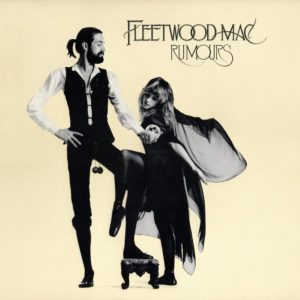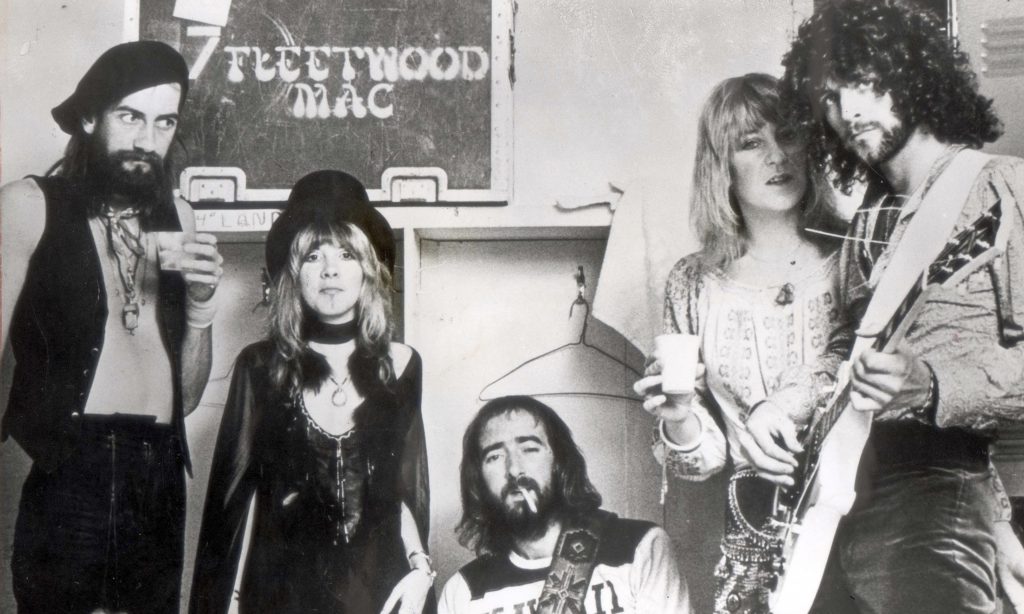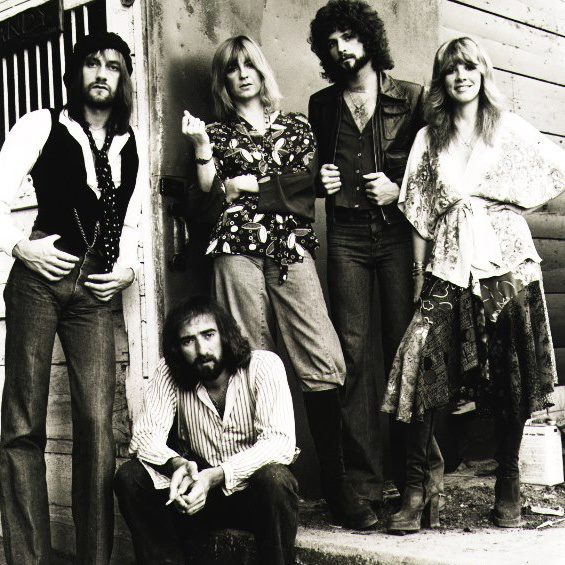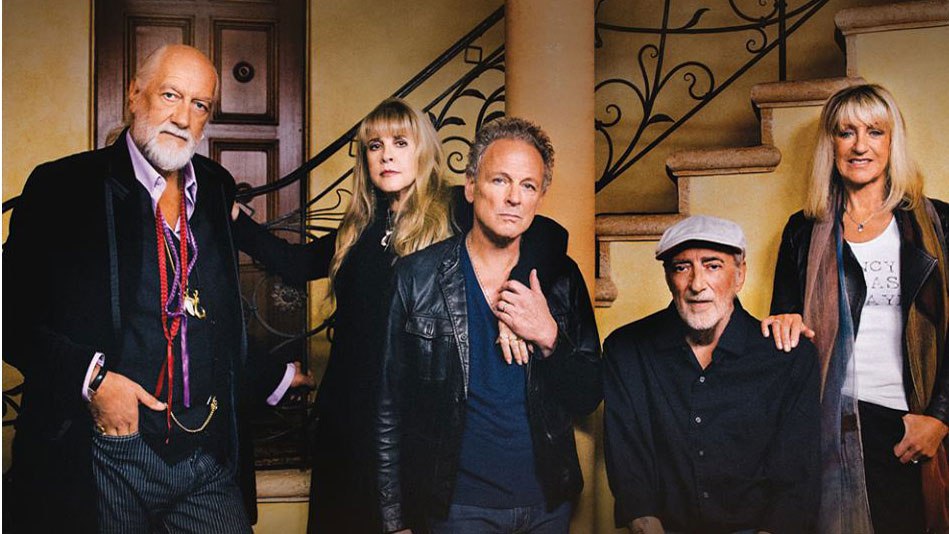
Fleetwood Mac | Rumors 40th Anniversary Retrospective
Label: Warner Bros. Records
Release Year: 1977
Country: USA
Genre: Classic Rock
Band Members
Stevie Nicks – Vocals
Mick Fleetwood – Drums/Percussion
John MacVie – Bass
Lindsey Buckingham – Guitar/Vocals
Christine MacVie – Keyboards/Vocals
Track List
Second Hand News
Dreams
Never Going Back Again
Don’t Stop
Go Your Own Way
Songbird
The Chain
You Make Loving Fun
I Don’t Want To Know
Oh Daddy
Gold Dust Woman
Contact Links
Fleetwood Mac Official Website
Fleetwood Mac Official Facebook Page
Fleetwood Mac Official Twitter
Fleetwood Mac Topic YouTube Channel
Warner Brothers Records Official Website

1977 was ground zero for new beginnings in the area of both pop culture and rock n roll. In the year that would eventually see the King Of Rock’n’ Roll Elvis Presley die. Director Roman Polanski pleaded guilty of raping a 13 year old girl in 1977 but fled the U.S to avoid charges, this is why his 2011 film Carnage, staring Jodie Foster, Kate Winslet, Christoph Waltz and John C. Reilly although set in New York was actually filmed in Paris. The deadliest (583 casualties) crash in Aviation history occurred not in the skies but on the runway between two Boeing 747s on March 27, 1977. Known as the ‘Tenerife Airport Disaster’. It happened at the runway at Los Rodeos Airport (now Tenerife North Airport), on the Spanish island of Tenerife, Canary Islands. Aerosmith’s flight crew inspected a Convair CV-240 for possible use and rejected it because they felt the plane and crew were not up to their standards. That plane crashed on October 20, 1977 from fuel exhaustion due to poor maintenance, killing three members of Lynyrd Skynyrd.
In the midst of all those very depressing headlines there was a full on musical revolution going on that would produce some of classic rock’s biggest selling and most influential bands and albums of all time. In New York’s Manhattan East Village you had the famous CBGB bar that would eventually produce future punk and early alternative icons The Ramones, Blondie, Talking Heads, Patti Smith, etc … who were allowed to thrive and grow due to many people being banned by Steve Rubell uptown at the Disco dive Studio 54. The birth of what would become Goliath’s in the film industry, Rock and Star Wars were released.
Meanwhile in other parts of the musical landscape it would both produce some of the best selling albums of all time and some of the most competitive music for the public’s attention and money. Rod Stewart would release Foot Loose & Fancy Free, The Bee Gees would become disco music staples and release the single “How Deep Is Your Love”. In the same year there was a musical revolution happening on America’s west coast. Van Halen would release their iconic Van Halen I debut, the Eagles would release one of the two iconic classic rock albums in Hotel California and up the coast near San Fransisco Fleetwood Mac would release Rumours.

Now I would be remiss in saying there was a lot of variables and things happening within Fleetwood Mac that served as poetic fuel for the creative fire that made Rumours one of the Top #5 albums of all time. When you hear cocaine, breakups, divorce and other secrets that shroud the making of Rumours it is all true and that truth would be reveled within many of the songs that would make Rumours. For you who are not as familiar with Fleetwood Mac Rumours, it was the band’s 11th album. This would be the second album with Stevie Nicks and Lindsey Buckingham.
You had two couples who were well into breakup’s and divorce and one couple that would secretly happen in the serious privacy until it would be revealed. John MacVie and Christine MacVie were well into divorce proceeding, Lindsey Buckingham and Stevie Nicks were in the beginning of a breakup/divorce and Stevie Nicks and Mick Fleetwood would start a secret relationship behind everyone’s back. It was a total debacle however in its own strangeness helped the creative process among the five members of Fleetwood Mac.
These were five members that through the course of the recording process of Rumours would go in as a band and come out as a true rock ‘supergroup’. Rumours would also relate to the social conscious of what the ‘Baby Boomer’ generation’s lifestyles and experience. Now let’s take a look back at some highlights and facts from each track from Fleetwood Mac’s Rumours.
Rumours Become Facts
Second Hand News was written by Fleetwood Mac frontman Lindsey Buckingham. It is the first track on the Rumours album – the most successful album of Fleetwood Mac’s career with sales of over 40 million worldwide, going 19x platinum in the US and 10x platinum in the UK. The band’s original drummer Mick Fleetwood calls it the most important album they ever made.
This song was originally an acoustic demo titled “Strummer.” But when Buckingham heard the Bee Gees’ “Jive Talkin’,” he rearranged it with more audio tracks and the rhythmic effect from “playing” the faux-leather seat of a studio chair to make it evoke a slightly Celtic feel.
Like many of the songs on the Rumours album, this one shows a darker side in the lyrics. It’s asking you to move on, leave the singer alone. Fleetwood Mac was experiencing the shatter of all of their emotional ties with not one, not two, but three break-ups! That was the divorce of the McVies, Buckingham and Stevie Nicks breaking up, and Fleetwood going through a divorce from his wife.
In Frank Moriarty’s book Seventies Rock: The Decade of Creative Chaos, Stevie Nicks is quoted from a Creem interview in July 1977, explaining the acrid lyrics: “We were all trying to break up and when you break up with someone you don’t want to see him. You especially don’t want to eat breakfast with him the next morning, see him all day and all night, and all day the day after…”
As if that weren’t enough, Seventies Rock also goes on to quote Nicks about the recording sessions on their next album: “It lasted thirteen months and it took every bit of inner strength we had. It was very hard on us, like being a hostage in Iran, and to an extent, Lindsay was the Ayatollah.”
Dreams During the sessions for Rumours, everyone in the band was going through a breakup (Stevie Nicks and Lindsey Buckingham with each other, John and Christine McVie with each other, Mick Fleetwood with his wife Jenny Boyd) and doing a lot of drugs. They were able to work together, but most of the songwriting was on an individual basis. Stevie Nicks wrote this in the studio next door, where Sly Stone was recording. He had a big, semicircular bed and red velvet all over the walls – a great vibe for a song about dreams.
The line “Players only love you when they’re playing” was directed at Lindsey Buckingham. Stevie Nicks was not pleased when he brought “Go Your Own Way” to the sessions, which was clearly about her. Stevie told Q magazine June 2009: “It was the fairy and the gnome. I was trying to be all philosophical. And he was just mad.”
This was Fleetwood Mac’s only #1 hit in the US.
Stevie Nicks recalled to The Daily Mail October 16, 2009: “I remember the night I wrote ‘Dreams.’ I walked in and handed a cassette of the song to Lindsey. It was a rough take, just me singing solo and playing piano. Even though he was mad with me at the time, Lindsey played it and then looked up at me and smiled. What was going on between us was sad. We were couples who couldn’t make it through. But, as musicians, we still respected each other – and we got some brilliant songs out of it.”
In 1998 a Todd Terry re-mix of a cover by The Corrs peaked at #6 in the UK. The Irish group originally recorded the song for a Fleetwood Mac tribute album. Mick Fleetwood, who is a fan of The Corrs, had asked them to record it.
Christine McVie said in a 1997 interview with Q: “‘Dreams’ developed in a bizarre way. When Stevie first played it for me on the piano, it was just three chords and one note in the left hand. I thought, This is really boring, but the Lindsey genius came into play and he fashioned three sections out of identical chords, making each section sound completely different. He created the impression that there’s a thread running through the whole thing.”
Christine McVie played both a Hammond organ and a Fender Rhodes electric piano on this track.
Never Going Back Again According to Q magazine June 2009 the inspiration for this Lindsey Buckingham penned song was a brief relationship with a woman whom he’d met on the road. Buckingham had only recently broken up with his Fleetwood Mac co-singer Stevie Nicks.
Most of the Rumours album was recorded at The Record Plant in Sausalito, California, but this song was recorded at Studio City Sound Recording Studios in Los Angeles. According to recording assistant Cris Morris, this song took a while to record. Said Morris: “It was Lindsey’s pet project, just two guitar tracks but he did it over and over again. In the end his vocal didn’t quite match the guitar tracks so we had to slow them down a little.”
Dont’ Stop Christine McVie wrote this about leaving the past behind. She and John McVie (Fleetwood Mac’s bass player) were splitting up, which inspired the lyrics. This caused some awkward moments, since John had to play a song written about him. Lindsey Buckingham and Stevie Nicks were also going through a breakup and writing songs about each other (“Go Your Own Way,” “Dreams”), and Mick Fleetwood was going through a divorce. All the tension in the studio didn’t seem to hurt – Rumours is one of the best-selling albums of all time.
The album was going to be called “Yesterday’s Gone,” after a line in this song. John McVie suggested “Rumours” because it seemed like everyone in Southern California was talking about the personal drama Fleetwood Mac was going through.
Bill Clinton used this as his theme song when he successfully ran for US president in 1992. He was the first baby boomer president, and he knew Fleetwood Mac would appeal to a lot of voters in this demographic.
There was some subtext to this pairing of song and politician: Clinton was a known philanderer, and had been through some rough times with his wife, Hillary. The song finds Christine McVie offering her husband a chance to move forward despite his transgressions:
Why not think about times to come
And not about the things that you’ve done
The vast majority of listeners didn’t pick up on this, as it was heard as a song of hope and renewal in the context of the campaign.
When Bill Clinton won the presidential election, Fleetwood Mac was thrust back into the spotlight because his campaign had used this song at every opportunity. At this time, the band was fractured, with Lindsey Buckingham out of the lineup since 1987 and Stevie Nicks out since 1991. And while Clinton couldn’t push through universal health care, he was able to get the Rumours-era Fleetwood Mac back together, as Buckingham and Nicks joined John and Christine McVie and Mick Fleetwood to perform at his inaugural gala in 1993 (the day before he was sworn into office).
Nothing came of the one-off reunion, and the band spent the next few years punching below their weight, even opening for REO Speedwagon. In 1997, Buckingham and Nicks returned to the fold and Fleetwood Mac was once again an arena act, embarking on their wildly successful The Dance tour.
Go Your Own Way Lindsey Buckingham wrote this as a message to Stevie Nicks. It describes their breakup, with the most obvious line being, “Packing up, shacking up is all you want to do.” Stevie insisted she never shacked up with anyone when they were going out, and wanted Lindsey to take out the line, but he refused.
Stevie Nicks told Q magazine June 2009: “It was certainly a message within a song. And not a very nice one at that.”
While the Rumours album was being recorded, the marriage of John and Christine McVie (both of them Mac members) was also coming to an end. With two couples breaking up during the sessions, recording could be quite tense. They were also doing lots of drugs at the sessions, making sure there was plenty of Behind The Music material.
This was the first single from the Rumours album, which became one of the best-selling of all time. Describing the recording process for this song in Q magazine, drummer Mick Fleetwood said: “‘Go Your Own Way’s’ rhythm was a tom-tom structure that Lindsey demoed by hitting Kleenex boxes or something. I never quite got to grips with what he wanted, so the end result was my mutated interpretation. It became a major part of the song, a completely back-to-front approach that came, I’m ashamed to say, from capitalizing on my own ineptness. There was some conflict about the ‘crackin’ up, shackin’ up’ line, which Stevie felt was unfair, but Lindsey felt strongly about. It was basically, On your bike, girl!”
Fleetwood Mac is not known for their guitar solos, but Lindsey Buckingham’s solo on this is one of his most notable. The live version on The Dance contains a much longer solo
Songbird This was Christine McVie’s solo on side 1 of the album. It proved her talent apart from the group. She wrote the song, sang it, and played the piano for it.
This is a very personal song for McVie about the self-sacrifice of true love. >>
Christine McVie has said that this song held Fleetwood Mac together during their hard times (while recording Rumours). Once the members heard this song, they thought how much they had been through and how much love they shared. >>
This was often used to close many Fleetwood Mac shows. >>
American singer Eva Cassidy’s cover was made the title track of a compilation album of recordings, which was released in 1998, two years after her death from melanoma. The album took off in the UK after Cassidy’s version of “Over the Rainbow” was played by Terry Wogan on his BBC Radio 2 breakfast show. The Songbird set went on to top the UK album charts, almost three years after its initial release. In 2009 an audition performance of Cassidy’s arrangement of this song by Shanna Goodhead on Britain’s The X-Factor, prompted enough interest to push the late American’s singer’s version into the UK Top 75 Singles Chart.
Christine McVie penned the song in half a hour after she woke up in the middle of the night with it in her head. She recalled to Mojo in 2015: “Stevie and I were in a condominium block and the boys were all in the Sausalito Record Plant house raving with girls and boozer and everything. I had a little transistorised electric piano next to my bed and I woke up one night at about 3.30am and started playing it. I had all, words, melody, chords in about 30 minutes. It was like a gift from the angels, but I had no way to record it. I thought I’m never gonna remember this. So I went back to bed, and couldn’t sleep. I wrote the words down quickly.”
“Next day, I went into the studio shaking like a leaf’ cos I knew it was something special. I said, ‘Ken, (Caillat, Rumours’ co-producer/engineer) put the 2-track on, I want to record this song!’ I think they were all in there, smoking opium.”
The Chain was another song that revolved arounf the break up situation within the band. Stevie Nicks wrote the lyrics about Lindsey Buckingham as their relationship was falling apart. Buckingham and Nicks share lead vocals on the song.
Pieces of different studio takes were spliced together to form the track. The bass line that comes in at about the 3 minute mark through the song was written independently by John McVie, who was originally planning to use it in a different song.
This began as a Christine McVie song called “Butter Cookie (Keep Me There),” which which is available on the expanded edition of Rumours. The beginning of the track wasn’t working, but the band loved Mick Fleetwood and John McVie’s ending, which was now on tape. So, they counted back from the bass line, used the kick-drum as a metronome, Nicks gave them the lyrics for the verses, Buckinghan and Christine McVie wrote the music and the chorus lyrics, Lindsey added the guitar over the ending, and “The Chain” as we know it was born. >>
This is the only Fleetwood Mac song credited to all 5 members of their 1977 lineup. Since various pieces were assembled to make the song, they all had some contribution.
This song came to represent the resilience of Fleetwood Mac and the strength of their bond as they continued on for many years despite their personal and professional difficulties. It’s the first song they play in concert.
The low bass line in this song was used by the BBC for the Grand Prix theme tune for many years.
Mick Fleetwood: “‘The Chain’ basically came out of a jam. That song was put together as distinct from someone literally sitting down and writing a song. It was very much collectively a band composition. The riff is John McVie’s contribution – a major contribution. Because that bassline is still being played on British TV in the car-racing series to this day. The Grand Prix thing. But it was really something that just came out of us playing in the studio. Originally we had no words to it. And it really only became a song when Stevie wrote some. She walked in one day and said, ‘I’ve written some words that might be good for that thing you were doing in the studio the other day.’ So it was put together. Lindsey arranged and made a song out of all the bits and pieces that we were putting down onto tape. And then once it was arranged and we knew what we were doing, we went in and recorded it. But it ultimately becomes a band thing anyway, because we all have so much of our own individual style, our own stamp that makes the sound of Fleetwood Mac. So it’s not like you feel disconnected from the fact that maybe you haven’t written one of the songs. Because what you do, and what you feel when we’re all making music together, is what Fleetwood Mac ends up being, and that’s the stuff you hear on the albums. Whether one likes it or not, this is, after all, a combined effort from different people playing music together.”
You Make Loving Fun During the recording of Rumours the marriage of bassist John McVie and keyboardist and co-singer Christine McVie was ending. Christine started seeing the band’s lighting technician Curry Grant and she penned this song about the relationship. Drummer Mick Fleetwood quipped to Q magazine June 2009: “Knowing John, he probably thought it was about one of her dogs.”
Christine McVie sang lead vocals on this track, which was one of four songs she wrote solo for the Rumours album. McVie had nothing prepared when the band started working on the album at The Record Plant studios in Sausalito, California. “I thought I was drying up,” she said in Q magazine. “I was practically panicking because every time I sat down at a piano, nothing came out. Then, one day in Sausalito, I just sat down and wrote in the studio, and the four-and-a-half songs of mine on the album are a result of that.”
Cyndi Lauper was commissioned in 1977 to record several soundalike covers of songs penned written by other artists – she was one of several session singers hired to re-record several big hits of the day. Lauper said later that she was paid only twelve dollars for her work, to “sound like someone else.” The only fruit to come from her sessions was a 7″ vinyl single of her version of this track, which became the first song ever officially released by the New York songstress. Lauper did not own her own copy until a fan gave her one in 2002.
I Don’t Want To Know “I Don’t Want to Know” was written by Stevie Nicks in 1974 before she joined Fleetwood Mac, and it was intended for a second album with her band Buckingham Nicks. The singer was initially unhappy about the decision to place the song on Rumours. The reason? It displaced another of Nicks’ tunes, “Silver Springs,” which she favored. The Fleetwood Mac frontwoman recalled in a 1991 BBC interview that when she asked Mick Fleetwood why “Silver Springs” was being removed, he replied: “There’s a lot of reasons, but because basically it’s just too long. And we think that there’s another of your songs that’s better, so that’s what we want to do.”
Nicks continued: “Before I started to get upset about ‘Silver Springs,’ I said, ‘What other song?’ And he said, ‘A song called I Don’t Want To Know.’ And I said, ‘But I don’t want that song on this record.’ And he said, ‘Well, then don’t sing it.’
And then I started to scream bloody murder and probably said every horribly mean thing that you could possibly say to another human being, and walked back in the studio completely flipped out. I said, ‘Well, I’m not gonna sing ‘I Don’t Want To Know.’ I am one-fifth of this band.’ And they said, ”You can either (a) take a hike or (b) you better go out there and sing ‘I Don’t Want To Know’ or you’re only gonna have two songs on the record.’ And so, basically, with a gun to my head, I went out and sang ‘I Don’t Want To Know.’ And they put Silver Springs on the back of ‘Go Your Own Way.'”
Oh Daddy Christine McVie wrote this song about the band’s drummer, Mick Fleetwood. The band was going through a lot of turmoil, as Christine and John McVie were having relationship issues as were Stevie Nicks and Lindsey Buckingham. Describing the mood of the sessions, Rumours co-producer Richard Dashut said (in Q magazine): “Defenses were wearing thin and they were quick to open up their feelings. Instead of going to friends to talk it out, their feelings were vented through their music: the album was about the only thing they had left.”
Gold Dust Woman Stevie Nicks wrote this song and sang lead. While Nicks has never been clear on the meaning, you can make a good case that it is about cocaine, which the band was consuming in quantity during the Rumours sessions. The lyrics, “Take your silver spoon, dig your grave,” can be seen as a reference to a spoon holding the drug.
Nicks’ relationship with Fleetwood Mac guitarist Lindsey Buckingham may also have influenced the song, as they had broken up and were going through some very difficult times, using songs as a medium for expressing their feelings to each other.
In Mick Fleetwood’s book My Life and Adventures in Fleetwood Mac, he explains that it took Nicks eight takes to get the vocal right, and they were recorded early in the morning. Fleetwood described Nicks as “hunched over in a chair, alternately choosing from her supply of tissues, a Vicks inhaler, a box of lozenges for her sore throat and a bottle of mineral water.”
Cris Morris, who was a recording assistant on the sessions, explained in Q magazine: “Recording ‘Gold Dust Woman’ was one of the great moments because Stevie was very passionate about getting that vocal right. It seemed like it was directed straight at Lindsey and she was letting it all out. She worked right through the night on it, and finally did it after loads of takes. The wailing, the animal sounds and the breaking glass were all added later. Five or six months into it, once John had got his parts down, Lindsey spent weeks in the studio adding guitar parts, and that’s what really gave the album its texture.”
Among the artists who have recorded this song: Waylon Jennings, Hole, Sheryl Crow and Sister Hazel.
Lindsay Buckingham plays a Dobro on this track. The Dobro is an acoustic guitar with a single resonator with its concave surface uppermost. The inventor of the resonator guitar, John Dopyera, together with his brothers Rudy, Emile, Robert, and Louis, developed the Dobro in 1928. They named it as a contraction of Dopyera Brothers’ coupled with the meaning of “goodness” in their native Slovak language. Gibson acquired exclusive use of the Dobro trademark in 1993 and the guitar corporation currently produces several round sound hole models under the Dobro name. One of these ornate guitars is featured on the cover of Dire Straits’ Brothers In Arms.

With this being the 40th Anniversary of Fleetwood Mac’s Rumours the band has sold a staggering 45 million plus units world wide according to the RIAA certification since its release. Next to The Eagles Greatest Hits and Michael Jackson’s Thriller, Fleetwood Mac’s Rumours sits in the Top 3 of greatest albums of all time. Fleetwood Mac’s Rumours continues to transcend generations to this day and will be one of those albums that will be continually talked about and listened to for future generations to come.



